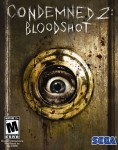$20 Game of the Week: Condemned 2 – Bloodshot (Xbox 360, PS3)
by William Talley, filed in $20 Game Of The Week, Games on Feb.05, 2009
 Weather they have you hunting down the city’s most dangerous serial killers or being stalked through hallways by a demonic little girl, Monolith knows how to pile on the scares just as good as any Silent Hill or Resident Evil title.. Bloodshot is the sequel to one of the Xbox 360’s earliest games, and it improves greatly upon its predecessor in almost every way. You once again step into the shoes of investigator Ethan Thomas. However, due to the events of the last game, you’re a mere shell of your former shelf. Having left the SCU, you drown your sorrows in the bottle until your former employers notify you of a mysterious call from Ethan Van Horn, a friend of yours who has gone missing. Soon, you once again get pulled back into a world of evil and mayhem, as it seems that Serial Killer X, who met his end at the end of the first game, has seemingly returned and has gone back to his old ways. Along the way, you’ll come to terms with your personal demons, your origin, learn the true nature of the mania that has gripped the streets, and get up close and personal to the cult that has hinted at in the last game.
Weather they have you hunting down the city’s most dangerous serial killers or being stalked through hallways by a demonic little girl, Monolith knows how to pile on the scares just as good as any Silent Hill or Resident Evil title.. Bloodshot is the sequel to one of the Xbox 360’s earliest games, and it improves greatly upon its predecessor in almost every way. You once again step into the shoes of investigator Ethan Thomas. However, due to the events of the last game, you’re a mere shell of your former shelf. Having left the SCU, you drown your sorrows in the bottle until your former employers notify you of a mysterious call from Ethan Van Horn, a friend of yours who has gone missing. Soon, you once again get pulled back into a world of evil and mayhem, as it seems that Serial Killer X, who met his end at the end of the first game, has seemingly returned and has gone back to his old ways. Along the way, you’ll come to terms with your personal demons, your origin, learn the true nature of the mania that has gripped the streets, and get up close and personal to the cult that has hinted at in the last game.
Like its predecessor, Bloodshot is a first-person shooter. I place key emphasis on the words ‘first-person’ and mention the word ‘shooter’ in passing. Yes there are guns (in fact more than in the original game), but you won’t be using them as frequently as you do in other FPS games. In fact, Ethan is a recovering alcoholic, so your aim will be wobbly whenever you aim a weapon, and you will need a sip of alcohol in order to stabilize your aim. You won’t be finding ammo conveniently lying on the floor. Just like in the original game, you’ll rely on whatever you can pick up off the ground, including lead pipes, wooden bars, toys, and anything else you can get your hands on. When all else fails, you can use your bare hands. You’ve learned quite a few tricks since the last game, as Ethan can pull off combos, finishing moves, special attacks, and can even drag enemies to environmental ‘hot spots’ a’la the Punisher. The game is 3 times longer than the first, and several unlockables will keep players coming back. There are also challenge levels and online multiplayer, although those seem to be tacked in as an after thought. It isn’t as if they aren’t fun to play, it’s just that they won’t be making anyone throw out their copies of Halo 3 anytime soon.
The criminal investigation tools from the first game have been taken out, but the new investigation method which takes its place is just as fun. When you arrive at a crime scene, you are presented with a series of questions about what happened, and it’s up to you to use the visual clues around the crime scene in order to find the answers. Answering correctly will help earn more points towards weapons upgrades. The only real forensic tool you have is a handheld device which has a test tube, PDA communicator, and digital camera built in. Even though I wish they would have expanded on the investigation sequences in the last game, the new question/answer mechanic helps to set the game apart from other survival horror games, and it helps to drive home the ‘CSI’ feel.
Although the game’s plot becomes somewhat disjointed towards the end, the game’s disturbing atmosphere is kept intact throughout the experience. The hallucinatory shifts will keep you guessing at what’s real and what’s fake, the enemies will have you scouring the environment for strategies and weapons to make use of, and there are moments in the game that will cause many a sleepless night. Developers who make survival horror games should grab a copy of this and study it. As I said with the first game, this would be an excellent example of how to do a first-person Silent Hill game. The game’s ending hints at a possible sequel. Hopefully Monolith will begin work on one, and push this series even further into prosperity.


 PS3
PS3
 Famicom Dojo
Famicom Dojo KEEP PLAYING
KEEP PLAYING KEEP PLAYING: Rewind
KEEP PLAYING: Rewind Powet Toys
Powet Toys Powetcast
Powetcast Hitchhiker's Guide POWETcast
Hitchhiker's Guide POWETcast














